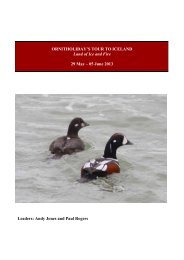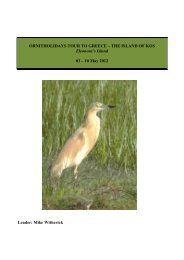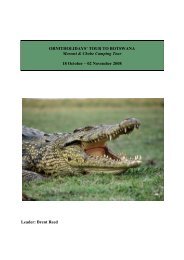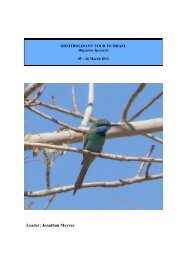Download 2014 Brochure (.pdf) - Ornitholidays
Download 2014 Brochure (.pdf) - Ornitholidays
Download 2014 Brochure (.pdf) - Ornitholidays
Create successful ePaper yourself
Turn your PDF publications into a flip-book with our unique Google optimized e-Paper software.
M O R O C C O<br />
Morocco<br />
High Atlas & Sahara<br />
Tuesday 08 April – Thursday 17 April <strong>2014</strong><br />
Leaders: David Walsh and local guides<br />
<strong>2014</strong> Cost £1,899 single room supplement £120<br />
Marrakech<br />
Ourika Valley<br />
Casablanca<br />
Ouarzazate<br />
Boumalne<br />
du Dadès<br />
Merzouga<br />
MOROCCO<br />
orocco is just a short flight from the UK but has birds, culture and scenery which<br />
M seem a world away! Our spring tour focuses on the mountains and deserts of<br />
inland Morocco, avoiding the long drives to and from the coast, and as such it provides a perfect complement to our annual autumn trip based in<br />
Agadir. April is an excellent time to visit the country, as we will not only see a superb array of sought-after resident species, but also a range of migrants<br />
heading north from sub-Saharan Africa to Europe. The variety of scenery on this trip is truly awe-inspiring! During our stay we will visit a wide range<br />
of habitats: high mountains, inland lakes, pine forests, spectacular gorges, stony desert and, perhaps most exciting of all, breathtaking sand dunes<br />
on the very edge of the Sahara. We hope to see some real specialities including Crimson-winged Finch, Levaillant’s Green Woodpecker, Blue-cheeked<br />
Bee-eater, Pharaoh Eagle Owl, Egyptian Nightjar, Spotted Sandgrouse, Desert Sparrow, African Desert Warbler, Cream-coloured Courser, Fulvous<br />
Babbler, Moussier’s Redstart and several wheatears and larks. <strong>Ornitholidays</strong> has now visited this country over 25 times, and the tour will be led by<br />
David Walsh who has been to Morocco on more than a dozen occasions.<br />
ITINERARY<br />
Days 1 & 2<br />
We fly from London direct to Marrakech where<br />
we meet our driver and transfer to our hotel in the<br />
Ourika Valley where we stay for two nights. From<br />
the hotel terrace we have a grandstand view<br />
towards the Atlas Mountains and we are likely to<br />
see Little Swift, Red-rumped Swallow, Sardinian<br />
Warbler, House Bunting, Common Bulbul,<br />
African Blue Tit and perhaps even a Hawfinch.<br />
The distinctive North African race of Common<br />
Chaffinch is common in the valley, whilst the<br />
songs of Common Nightingale and European<br />
Serin will become very familiar sounds.<br />
The following day we head for the alpine area<br />
around the ski resort of Oukaimeden, marvelling<br />
at the superb mountain scenery with its snowcovered<br />
peaks. Here we hope to find<br />
Crimson-winged Finch, Horned Lark, Common<br />
Rock Sparrow, and the recently split Seebohm’s<br />
Wheatear. Large flocks of Alpine and Red-billed<br />
Choughs frequent the area, whilst other likely<br />
species for us to enjoy include Black Redstart,<br />
Black Wheatear, Blue Rock Thrush, Water Pipit<br />
and White-throated Dipper. After the first of many<br />
fine tagine lunches, we will drift down to an area<br />
of orchards and woodland hoping to find<br />
Common Crossbill, Firecrest and Rock Bunting<br />
alongside Levaillant’s Green Woodpecker and<br />
Moussier’s Redstart, two species endemic to the<br />
Maghreb region (Morocco, Algeria and Tunisia).<br />
Moroccan Orange Tip and Scarce Swallowtail<br />
are among the butterfly possibilities.<br />
Day 3<br />
This morning we have another chance to see the<br />
special birds of the Ourika Valley before crossing<br />
an area of plains south-east of Marrakech. We<br />
then head south-east, travelling uphill through<br />
some of the most spectacular landscapes in<br />
Morocco. Our route takes us over the Tizi-n-<br />
Tichka Pass at around 2,260m. By the roadside,<br />
boys attend stalls crowded with gems and fossils,<br />
products of the local mountainsides and valleys.<br />
Our journey should provide opportunities to view<br />
Common Raven, Thekla Lark, Barbary Partridge,<br />
migrant European Bee-eaters and Woodchat<br />
Shrikes and several raptors, including perhaps<br />
Booted and Short-toed Eagles. Tristram’s Warbler<br />
favours the stunted vegetation of the dry slopes<br />
and we will search for it, but it can sometimes be<br />
a difficult species to locate. From the dizzy<br />
heights of the High Atlas, we drop down into the<br />
fertile oasis around Ouarzazate and to our hotel,<br />
around which we might find flocks of White<br />
Storks and Cattle Egrets.<br />
Days 4 & 5<br />
To the east of Ouarzazate lies the Mansour Lake,<br />
a magnet for both resident and migrant species<br />
including Ruddy Shelduck, Eurasian Spoonbill,<br />
Purple Heron and both Gull-billed and Black<br />
Terns. The Saharan race of Eastern Olivaceous<br />
Warbler breeds here, whilst we have our first<br />
chance of seeing Fulvous Babbler, the colourful<br />
Blue-cheeked Bee-eater and the long-billed race<br />
of Crested Lark. After spending much of the<br />
morning around the lake, our journey will<br />
continue eastwards along the picturesque Dadès<br />
valley, aptly named both the ‘Valley of a thousand<br />
Kasbahs’ and the ‘Valley of Roses’: the beautiful<br />
pink roses are harvested annually to make<br />
scented rose water. We should start to notice<br />
smart White-crowned Wheatears along the way<br />
and have our first opportunity to locate the elusive<br />
Maghreb Wheatear, a recent split from Mourning.<br />
After lunch in shade by the river, we reach our<br />
impressive hotel in Boumalne, our base for the<br />
next two nights, where Moroccans dressed in<br />
local costume may well serenade us on arrival!<br />
The following morning should be one of the most<br />
exciting of the trip! We make an early start for the<br />
short drive to the arid plain to the south-east of<br />
the town, the “Tagdilt Track”. Species to be<br />
anticipated include Great Grey Shrike of the<br />
Lanner Falcon<br />
62<br />
For a previous tour report or further information please call: 01794 519445








